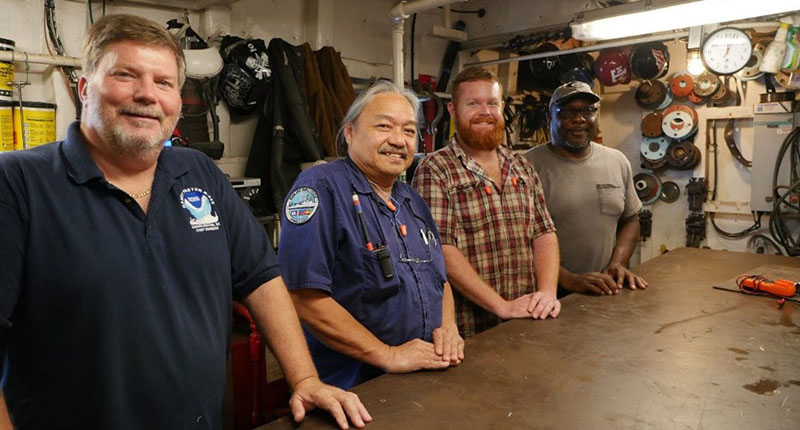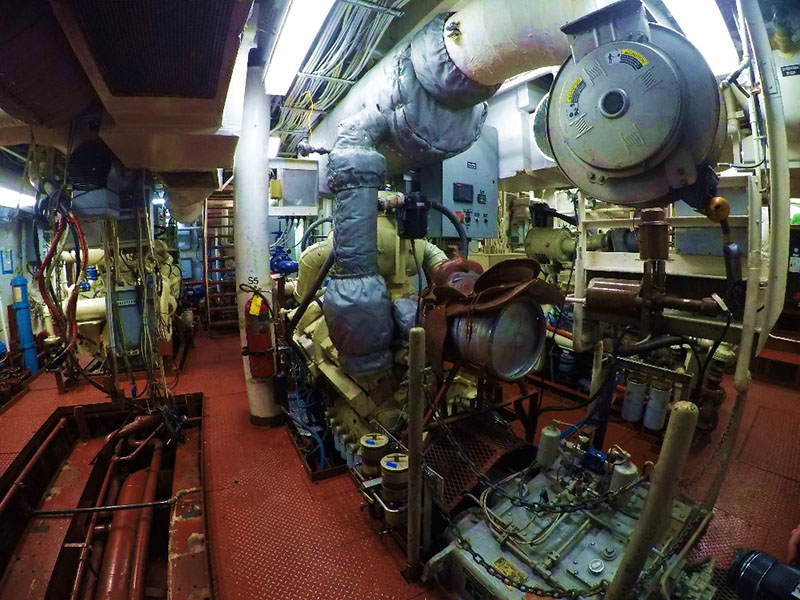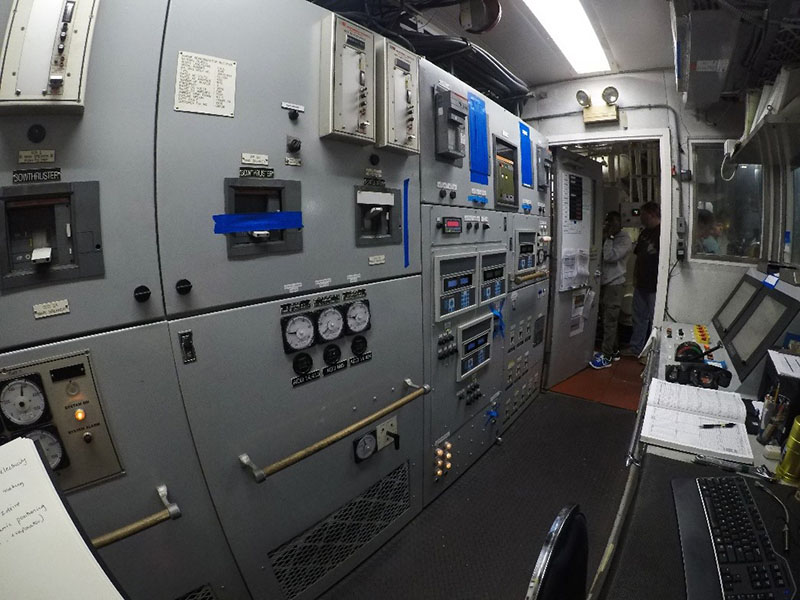
By Mallory Brooks, Bethune-Cookman University,
Leah Fine, U.S. Department of State Office of Marine Conservation,
Katie Geddes, NOAA Office of International Activities
August 25, 2017

The engineering department of NOAA Ship Nancy Foster. From left to right: CME Tim Olsen, 1AE Carlito Delapina, 2AE Kyle Williams and JUE Joe Clark. Image courtesy of Ralf Meyer, Green Fire Productions. Download larger version (jpg, 353 KB).
By the time NOAA Ship Nancy Foster reached the port in St. Petersburg on August 24, culminating the first leg of the Southeast Deep Coral Initiative (SEDCI) expedition, the ship traveled close to 1,500 miles in just under two weeks. By the time the ship will reach port in Charleston a week later, it will have covered another 1,000 miles.
Motoring across such vast expanses of ocean requires a dedicated crew, hard work, and powerful engines. Tim Olsen, Chief Machinery Engineer (CME) of NOAA Ship Nancy Foster, takes us on a tour into the belly of the beast, to showcase the impressive machinery that makes all of this work possible.
CME Olsen first brings us into the main engine room. This engineering space houses three generators and the main engine that powers the ship. The generators pack a major punch with over 1200 kilowatts of power, enough to power 80 small homes.
Scientists and crew need the ship to run smoothly, so three new generators were recently purchased. In order to get the generators inside of the compact ship, the crew will need to disassemble and reassemble them once inside the engine room. The single, 1250 shaft horsepower engine is a Cummins engine, similar to the engines found on many other ships. The Cummins engine was modified to fit the ship and has since powered the ship through rough and calm seas around the world.

The engine room of NOAA Ship Nancy Foster. Image courtesy of Mallory Brooks, Bethune-Cookman University. Download larger version (jpg, 524 KB).
CME Tim Olsen then leads us through another room that houses the ship’s two water makers, which convert seawater to potable water. One works through reverse osmosis, and the other through evaporation. Collectively, they can make 3,000 gallons of drinking water per day, more than enough to quench the thirst of the ship's hard-working crew.
A side door leads to storerooms, where the crew keeps two spares of every part needed to run the ship. Redundancy and self-sufficiency are paramount when the ship is in remote waters far away from shore.
CME Olsen has known Nancy Foster since the ship’s first days with NOAA, over 14 years ago. The ship was originally commissioned by the U.S. Navy in 1990 as a torpedo recovery ship, but the ship didn't spend much time in action. NOAA purchased the ship in 2001, and after a lengthy yard period, repurposed the ship as a scientific research vessel for use in 2004. CME Olsen is the only remaining original crew member from those early days. He has almost 35 years of experience at sea, over a third of which has been aboard NOAA Ship Nancy Foster.
He remembers the challenging process of getting the engines working seamlessly when he first started. While those first six months were difficult, now, he says “I love Nancy… She’s a good ol’ girl.” He also likes the schedule of Nancy Foster, which takes the ship around the Caribbean, the Gulf of Mexico, and the East Coast of the United States, to support science missions throughout these areas.

The engine control room of NOAA Nancy Foster. Image courtesy of Mallory Brooks, Bethune-Cookman University. Download larger version (jpg, 391 KB).
Thanks to CME Olsen and his team, Nancy Foster continues to chug along at average speeds around 10.5 knots (12 miles/hour), but the ship can reach speeds of 16 knots (>18 miles/hour) if the current is working in favor. With four major thrusters, Nancy Foster excels at dynamic positioning, making the ship a perfect platform for operations that require precise maneuvering, such as the remotely operated vehicle dives conducted during this expedition.
The science team, meanwhile, gets to take advantage of state-of-the-art equipment and an exceptional, kind, and hard-working crew willing to take us into the belly of the beast and showcase what keeps the ship moving, the lights on, and makes these missions possible.
The expedition is supported by NOAA’s Deep Sea Coral Research and Technology Program through the Southeast Deep Coral Initiative (SEDCI), a multi-disciplinary effort that will study deep-sea coral ecosystems across the Southeast United States in 2016-2019.